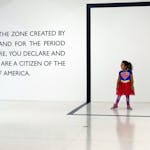Nobody would call the West Bank Jesus mural a sophisticated work of art. Least of all the two men responsible for painting it.
"I've painted, I don't know, probably 100 murals since then," said Jason Prigge, a 23-year-old artist when he bestowed Minneapolis with the vibrant mural in October 1997. "I've gotten a hell of a lot better."
"The whole rainbow, the love power — it was a little much for me," added Daryn Warriner, a former Minneapolis painting contractor. "I'm not all that excited about being attached to it."
Yet the colorful mural serves as one of Minneapolis' most prominent religious symbols, gracing the Cedar-Riverside neighborhood with its Christian-hippie vibe.
As a kid in the 1980s, I fell in love with the Jesus mural. I remember strategically positioning myself in the back of my family's Oldsmobile for our drive home from Valleyfair, just for a quick glimpse. Decades later, whenever I saw the mural, I remembered that tween in the back of the station wagon — a churchy kid, a committed Catholic Charities volunteer, someone who favored Up With People songs and 1970s Christian folk art.
"That picture is everything we stand for as a church," declared Janet Gullickson, senior pastor of the evangelical congregation that commissioned the mural. The outstretched arms, the welcoming rainbow — they're symbols for the church's openness and love, she explained. No wonder softies like me are attracted to it.
Turns out, the Jesus mural I first encountered in the late 1980s was different from the current iteration.
Gullickson wasn't sure when Jesus first appeared on the two-story brick building at 1407 Washington Av., built in 1932 to house the Children's Gospel Mission.
One of the mission's fundraising brochures from the early '80s shows a simple figure painted on a stark white wall. His gesture is identical to the current Jesus, but there was no rainbow, no blue sky. And he stood just 6 or 7 feet tall, Gullickson said.
This was a Jesus "with no definition in the face," said Warriner, now a software engineer in southern Missouri. "It looked like somebody started something and didn't really finish it."
Love Power Church started renting the building in 1995. It didn't take long for the church's founding pastor, Ann Sandell, to start dreaming up improvements for the mural.
"God gave her a vision" for a brighter, more inviting painting, Gullickson explained. "She always wanted to have a billboard for him."
So the church hired Warriner, a former student at North Central University, a small Pentecostal college near downtown Minneapolis. And Warriner contracted the job out to Prigge, an inexperienced muralist — and, notably, an agnostic.
"They wanted something that was very bright and colorful and had Jesus on it," remembered Prigge, who owns a digital media company in eastern Wisconsin. "I'm not a Christian, per se, but Jesus has always been one of my heroes, just like John Lennon. I was OK with not being a Christian and doing it."
By the time Prigge arrived for the job, the 40- by 100-feet wall was already primed. It took two full weeks to complete the enormous painting. And he enlisted Warriner's help with the trickiest part: the rainbow. "The arch was difficult to get right," Prigge said. "I did it two or three times."
Prigge and Warriner also recalled uncomfortable conversations concerning Christ's skin color.
"We really wanted him to be more Middle Eastern, to look Jewish," Warriner said.
But the congregation wanted "a blond-haired, blue-eyed Jesus," Prigge said. "I tried to make him as dark-skinned as I could. People at the church were not too happy with it."
Saving Jesus
Warriner insisted that the original 1997 mural has been modified. "I think they lightened the hair, the skin tone, the eye color," he said. "I think they made the eyes a lot larger."
"The face was definitely altered," Prigge agreed. "I didn't paint him with blue eyes."
It's true that the mural has required touch-ups, Gullickson said, occasionally to cover graffiti. "As we stood back, we saw that we wanted to put more highlights in the face of Jesus," she added. "We've done highlights; we've done lowlights."
As for the eyes, she admits the church changed them. "Pastor Ann has stood before Jesus," she said, referring to near-death experiences, "and she saw his eyes were blue."
Now the 20-year-old mural is cracked and peeling, the casualty of aging masonry and a leaky roof. "It hurts our heart that it looks the way it does," said Rick Larson, Love Power's music minister.
An anonymous donor recently gave the church $1,000 to "beautify" the mural, Gullickson said, but first the landlord must do some tuck-pointing and repair the roof. Only then will the congregation make arrangements to conserve the landmark. "I'll get up there in a cherrypicker if I have to," Larson said. "And then you'll really have to pray."
And I hope they're successful. Because the Jesus mural has been with us for decades, lending the city character and kitsch. The truth is, my enthusiasms were dampened by learning of the work's history, but I'll still miss it if it chips and peels away.




